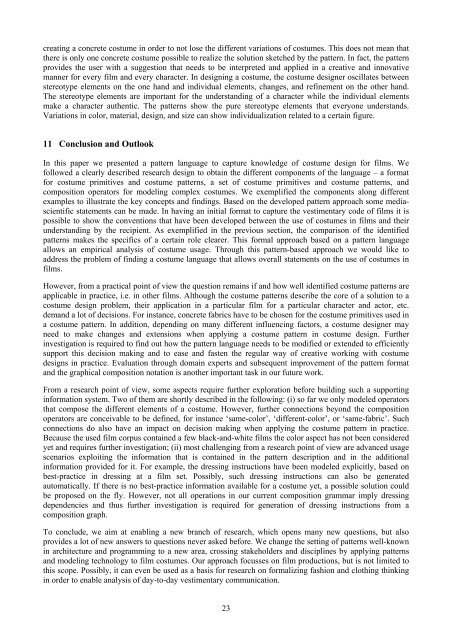A Pattern Language for Costumes in Films - IAAS
A Pattern Language for Costumes in Films - IAAS
A Pattern Language for Costumes in Films - IAAS
Create successful ePaper yourself
Turn your PDF publications into a flip-book with our unique Google optimized e-Paper software.
creat<strong>in</strong>g a concrete costume <strong>in</strong> order to not lose the different variations of costumes. This does not mean that<br />
there is only one concrete costume possible to realize the solution sketched by the pattern. In fact, the pattern<br />
provides the user with a suggestion that needs to be <strong>in</strong>terpreted and applied <strong>in</strong> a creative and <strong>in</strong>novative<br />
manner <strong>for</strong> every film and every character. In design<strong>in</strong>g a costume, the costume designer oscillates between<br />
stereotype elements on the one hand and <strong>in</strong>dividual elements, changes, and ref<strong>in</strong>ement on the other hand.<br />
The stereotype elements are important <strong>for</strong> the understand<strong>in</strong>g of a character while the <strong>in</strong>dividual elements<br />
make a character authentic. The patterns show the pure stereotype elements that everyone understands.<br />
Variations <strong>in</strong> color, material, design, and size can show <strong>in</strong>dividualization related to a certa<strong>in</strong> figure.<br />
11 Conclusion and Outlook<br />
In this paper we presented a pattern language to capture knowledge of costume design <strong>for</strong> films. We<br />
followed a clearly described research design to obta<strong>in</strong> the different components of the language – a <strong>for</strong>mat<br />
<strong>for</strong> costume primitives and costume patterns, a set of costume primitives and costume patterns, and<br />
composition operators <strong>for</strong> model<strong>in</strong>g complex costumes. We exemplified the components along different<br />
examples to illustrate the key concepts and f<strong>in</strong>d<strong>in</strong>gs. Based on the developed pattern approach some mediascientific<br />
statements can be made. In hav<strong>in</strong>g an <strong>in</strong>itial <strong>for</strong>mat to capture the vestimentary code of films it is<br />
possible to show the conventions that have been developed between the use of costumes <strong>in</strong> films and their<br />
understand<strong>in</strong>g by the recipient. As exemplified <strong>in</strong> the previous section, the comparison of the identified<br />
patterns makes the specifics of a certa<strong>in</strong> role clearer. This <strong>for</strong>mal approach based on a pattern language<br />
allows an empirical analysis of costume usage. Through this pattern-based approach we would like to<br />
address the problem of f<strong>in</strong>d<strong>in</strong>g a costume language that allows overall statements on the use of costumes <strong>in</strong><br />
films.<br />
However, from a practical po<strong>in</strong>t of view the question rema<strong>in</strong>s if and how well identified costume patterns are<br />
applicable <strong>in</strong> practice, i.e. <strong>in</strong> other films. Although the costume patterns describe the core of a solution to a<br />
costume design problem, their application <strong>in</strong> a particular film <strong>for</strong> a particular character and actor, etc.<br />
demand a lot of decisions. For <strong>in</strong>stance, concrete fabrics have to be chosen <strong>for</strong> the costume primitives used <strong>in</strong><br />
a costume pattern. In addition, depend<strong>in</strong>g on many different <strong>in</strong>fluenc<strong>in</strong>g factors, a costume designer may<br />
need to make changes and extensions when apply<strong>in</strong>g a costume pattern <strong>in</strong> costume design. Further<br />
<strong>in</strong>vestigation is required to f<strong>in</strong>d out how the pattern language needs to be modified or extended to efficiently<br />
support this decision mak<strong>in</strong>g and to ease and fasten the regular way of creative work<strong>in</strong>g with costume<br />
designs <strong>in</strong> practice. Evaluation through doma<strong>in</strong> experts and subsequent improvement of the pattern <strong>for</strong>mat<br />
and the graphical composition notation is another important task <strong>in</strong> our future work.<br />
From a research po<strong>in</strong>t of view, some aspects require further exploration be<strong>for</strong>e build<strong>in</strong>g such a support<strong>in</strong>g<br />
<strong>in</strong><strong>for</strong>mation system. Two of them are shortly described <strong>in</strong> the follow<strong>in</strong>g: (i) so far we only modeled operators<br />
that compose the different elements of a costume. However, further connections beyond the composition<br />
operators are conceivable to be def<strong>in</strong>ed, <strong>for</strong> <strong>in</strong>stance ‘same-color’, ‘different-color’, or ‘same-fabric’. Such<br />
connections do also have an impact on decision mak<strong>in</strong>g when apply<strong>in</strong>g the costume pattern <strong>in</strong> practice.<br />
Because the used film corpus conta<strong>in</strong>ed a few black-and-white films the color aspect has not been considered<br />
yet and requires further <strong>in</strong>vestigation; (ii) most challeng<strong>in</strong>g from a research po<strong>in</strong>t of view are advanced usage<br />
scenarios exploit<strong>in</strong>g the <strong>in</strong><strong>for</strong>mation that is conta<strong>in</strong>ed <strong>in</strong> the pattern description and <strong>in</strong> the additional<br />
<strong>in</strong><strong>for</strong>mation provided <strong>for</strong> it. For example, the dress<strong>in</strong>g <strong>in</strong>structions have been modeled explicitly, based on<br />
best-practice <strong>in</strong> dress<strong>in</strong>g at a film set. Possibly, such dress<strong>in</strong>g <strong>in</strong>structions can also be generated<br />
automatically. If there is no best-practice <strong>in</strong><strong>for</strong>mation available <strong>for</strong> a costume yet, a possible solution could<br />
be proposed on the fly. However, not all operations <strong>in</strong> our current composition grammar imply dress<strong>in</strong>g<br />
dependencies and thus further <strong>in</strong>vestigation is required <strong>for</strong> generation of dress<strong>in</strong>g <strong>in</strong>structions from a<br />
composition graph.<br />
To conclude, we aim at enabl<strong>in</strong>g a new branch of research, which opens many new questions, but also<br />
provides a lot of new answers to questions never asked be<strong>for</strong>e. We change the sett<strong>in</strong>g of patterns well-known<br />
<strong>in</strong> architecture and programm<strong>in</strong>g to a new area, cross<strong>in</strong>g stakeholders and discipl<strong>in</strong>es by apply<strong>in</strong>g patterns<br />
and model<strong>in</strong>g technology to film costumes. Our approach focusses on film productions, but is not limited to<br />
this scope. Possibly, it can even be used as a basis <strong>for</strong> research on <strong>for</strong>maliz<strong>in</strong>g fashion and cloth<strong>in</strong>g th<strong>in</strong>k<strong>in</strong>g<br />
<strong>in</strong> order to enable analysis of day-to-day vestimentary communication.<br />
23
















